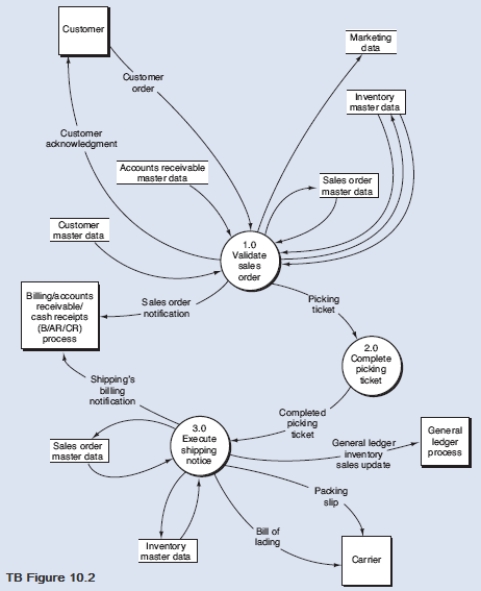Below is a narrative of the "Validate sales order" portion (i.e., bubble 1.0) of the order entry/sales process.
Narrative Description
How does the OE/S process then validate a customer order? First, process 1.1 verifies the availability of the requested inventory by consulting the inventory master data. If a sufficient level of inventory is on hand to satisfy the request, the order is forwarded for further processing, as depicted by the data flow "Inventory available order." Conversely, if a customer orders goods that are not in stock, process 1.1 runs a special back order routine. This routine determines the inventory requirement necessary to satisfy the order and then sends the back order request to the purchasing department. This activity is depicted by the "Back order" data flow, which in reality is a specific type of exception routine (i.e., a specific type of reject stub). If the customer refuses to accept a back order, then the sales event is terminated and the order is rejected, as shown by the "Reject" data flow. Information from the order (e.g., sales region, customer demographics, and order characteristics that reflect buying habits) that has potential value to marketing is recorded in the marketing data store.
After assuring inventory availability, process 1.2 establishes the customer's existence and then evaluates credit. The credit check adds the amount of the order to accounts receivable balances and open sales orders (i.e., orders about to be receivables), and compare that total to the credit limit. If the customer has exceeded their credit limit, the order is rejected.
Upon a successful credit approval, process 1.3 performs the following activities simultaneously:
.
.
Required:
From the DFD in TB Figure 10.2 and the narrative description above, explode bubble 1.0 into a lower-level diagram showing the details of that process.

Definitions:
Start Button
A user interface element, typically found in the lower left corner of the screen in Windows operating systems, that provides access to programs, folders, and system settings.
Document Thumbnail
A small representation or preview of a document's first page or a specific page, used for quick identification or navigation.
Word Start Screen
The initial interface or display seen upon launching Microsoft Word, offering access to templates, recent documents, and other features.
Word Window
The Word Window is the main interface of Microsoft Word where users can type, edit, format, and view documents.
Q6: Combining the functions of authorizing and executing
Q16: Which of the following is a data
Q29: The business document that accompanies the purchased
Q32: A(n) _ is a business document used
Q75: Which of the following shows start and
Q77: The terms _ planning, disaster recovery planning,
Q93: In general, adjustments to customer balances in
Q115: In a(n) _ billing system, invoices are
Q115: COBIT was developed by:<br>A) COSO<br>B) IT Governance
Q145: Watching a user type in passwords or